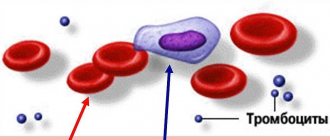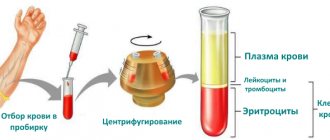0
Author of the article: Marina Dmitrievna
2017.08.14
471
Red blood cells
The need for periodic testing is especially acute for a woman during such an important period of life as pregnancy. At this time, the expectant mother worries not only about her health, but also about the well-being of her child.
Every doctor will say with confidence that minor deviations from the norm in the test results of a pregnant woman are acceptable due to significant restructuring of the body during this period, aimed at bearing a fetus. Therefore, it is important to correctly assess the situation if increased or decreased red blood cells are detected in the blood during pregnancy.
Important! A change in this indicator can be both a temporary phenomenon and a reason for a more detailed examination of the patient in order to exclude a serious disease. A qualified specialist will help you understand this matter.
Normal or pathological?
Changes in a woman’s body during pregnancy can lead to the development of phenomena that are unusual for her, including a decrease in the level of red blood cells.
It is worth noting that this is not so rare. According to statistics, during pregnancy, red blood cells in the blood are low in 40% of women! And it's very easy to explain. During pregnancy, the total volume of blood in the body increases. Its liquid part does this faster than formed elements (erythrocytes, leukocytes, etc.). In this case, experts talk about a false decrease in the level of red blood cells.
But there are also pathological reasons for a decrease in the level of red blood cells in expectant mothers. We will talk about them a little below.
Red blood cells are low during pregnancy: causes, norm, treatment
The main purpose of red blood cells is to transport oxygen to all tissues and remove carbon dioxide. Blood cells have a rich red hue due to the presence of hemoglobin. Red blood cells in pregnant women undergo constant and intensive renewal, since the child’s breathing inside the womb depends on this.
When conducting a clinical blood test, the volume of blood cells is determined and expressed in hematocrit value. The percentage norm should be no less than 36% and no more than 42%. Before conception, this indicator fluctuates depending on the monthly cycle.
The maximum parameters are observed at the beginning, and closer to the middle, during the period of ovulation, the volume gradually decreases.
Red blood cells in the blood during pregnancy vary depending on the period.
Immediately after conception, the number of blood cells is small, but as the embryo grows, the concentration gradually increases due to the appearance of a second circle of blood circulation around the baby.
At the beginning, the blood contains 4.2-5.4 million cells, but already the 3rd trimester is characterized by 3.7-5.0 million per 1 μl. If a woman is susceptible to toxicosis, then the parameters are significantly reduced due to dehydration.
A slight fluctuation and deviation in the number of red blood cells in the analysis is not considered a pathology, since during pregnancy a woman’s body undergoes hormonal changes and experiences a high load, which certainly affects the research results.
Functions of red blood cells and their norm
Externally, red blood cells look like biconcave cells that are red in color. They acquire this shade thanks to hemoglobin. This is the name of the pigment that ensures the activity of red blood cells.
The function of red blood cells is to supply organs with oxygen. The cells contribute to the removal of carbon dioxide and its transportation to the lungs for exhalation, distribute useful substances throughout the body, and take part in the acid-base balance of human blood.
The number of red blood cells is not constant. Its increase or decrease is observed throughout the day. But there are limits beyond which the indicator should not go. Otherwise, there is reason to believe that pathology is developing, or that some physiological factors are affecting the body.
Normal red blood cell levels are:
- Newly born babies have from 4 to 6.6 *10¹² units per liter of blood.
- In infants up to 2 weeks - from 3.6 to 6.2.
- Per month of life – from 3 to 5.4.
- From 2 to 6 months – from 2.7 to 4.9.
- From 7 to 11 months – from 3.1 to 4.6.
- From one to 2 years – from 3.7 to 4.4.
- From 3 to 12 years – 4 – 4.5.
- From 13 to 19 years old - from 3.9 to 5.6 for boys, and from 3.5 to 5.5 for girls.
- In adulthood, for men - from 4.2 to 5.3, for women - from 3.5 to 5.2.
Red blood cells
Why are red blood cells low during pregnancy?
Low red blood cells in the first three months of pregnancy are considered a normal phenomenon, which is associated with the fact that the volume of blood increases due to the liquid component, and the formed elements do not yet have time to be produced in large quantities, so indicators appear below normal. Also, this condition is allowed when fluid is retained in the body, when edematous reactions occur.
If red blood cells are low, then anemia and a lack of hemoglobin are automatically diagnosed, which poses a danger to the formation of the internal organs of the embryo. In this case, additional tests will be prescribed to find out the reasons for the development of the pathology.
Low rates may occur as a result of the following factors:
- Poor nutrition (lack of iron, folate or B vitamins);
- blood loss of various types;
- diseases of internal organs (kidneys, liver, heart);
- inflammatory and infectious processes;
- oncological diseases (tumors, leukemia);
- emotional instability and fatigue;
- hormonal deficiency.
If a short period of time has passed between the first birth and the second conception, then this often affects the fact that red blood cells are reduced, so it is recommended to plan the next pregnancy no earlier than in 3-3 years.
In addition, the 2nd trimester may be caused by the appearance of antibodies to red blood cell antigens.
An immunological conflict arises due to the incompatibility of the blood of the woman and the fetus according to the Rh factor (the mother is Rh positive, the baby inherited it from the father - negative), thus, hemolytic disease develops in the child.
Often, antibodies to red blood cells arise in large quantities only during repeated pregnancy; they are able to penetrate the placenta and behave aggressively towards the baby’s blood cells, causing increased hypoxia.
Reasons for the decrease in the indicator
When a blood test shows that your red blood cell count is low, doctors call it erythropenia. What can cause a low cell count?
Low red blood cells in the blood are caused by the following phenomena:
- Bleeding. Occurs as a result of injuries when large vessels, liver or spleen are damaged. Blood loss can occur with stomach ulcers and hemorrhoids. When a person suffers severe bleeding, he experiences hemorrhagic shock, which is accompanied by a drop in blood pressure and deterioration in the functioning of internal organs. Then comes posthemorrhagic anemia, in which low red blood cells are observed in the blood.
- Deficiency of red blood cell formation. Occurs when the body does not have enough components that are needed for the proper formation of blood cells. For example, there is little iron, folic acid, vitamin B12. A deficiency of these components occurs when there are disorders in the digestive tract or consumption of foods containing small amounts of these substances.
- Infectious diseases. Red blood cells decrease if a person suffers from a severe infectious disease or the body is infected with parasites.
- Malignant neoplasms. A decrease in the level of red blood cells is observed after chemotherapy, which is prescribed to patients suffering from cancer.
- Autoimmune disorders. Antibodies are produced in the blood against blood cells.
- Treatment with medications. There are drugs that can reduce the level of red blood cells: Phenobarbital, Corvalol.
All of these reasons can lead to a decrease in the level of red blood cells in the blood. Some pose a serious threat to human health and life, so it is important to identify them in order to quickly raise the level of red blood cells.
Bleeding is one of the reasons for low red blood cell levels
Why are red blood cells elevated during pregnancy?
Increased red blood cells in the blood during pregnancy provoke oxygen starvation in the child inside the womb. Due to high density indicators, transport function is disrupted, blood circulation slows down and stagnates, and the risk of thrombosis increases.
Source: https://ukb1.ru/krov/eritrocity-ponizheny-u-vzroslogo.html
Normal limits
A general blood test in pregnant women should show approximately the following results:
- In the first trimester (*1012 / l) - 3.5-5.4;
- In the second trimester (*1012 / l) – 3.2-4.8;
- In the third trimester (*1012 / l) – 3.5-5.0.
By the way, in non-pregnant women the norm of red blood cells in the blood is in the range (*1012 / l) 3.9-4.7.
Causes of the problem
Low red blood cells in the blood during pregnancy can result from a number of reasons:
- irrational or improper nutrition;
- large blood losses suffered before pregnancy;
- problems with the heart, liver, kidneys;
- anemia;
- iron deficiency;
- deficiency of vitamins in the body, in particular group B;
- the presence of a chronic focus of inflammation;
- infectious diseases;
- parasitic diseases;
- autoimmune diseases;
- exhaustion that was caused by problems in the field of neurology;
- frequent stress;
- a small gap between the previous and current pregnancies;
- hormonal imbalances;
- the presence of cancer tumors at the metastasis stage;
- taking certain types of medications;
- leukemia;
- destruction of erythroid cells.
All these pathologies will noticeably affect not only the health of the pregnant woman herself, but also the body of the not yet fully formed fetus.
When to sound the alarm?
During pregnancy, low red blood cells can be detected only after a blood test. However, there are several signs that can indicate the presence of a problem and alert a woman:
- constant lethargy;
- causeless weakness;
- drowsiness and desire to go to bed immediately after getting up in the morning;
- chronic fatigue;
- lowering blood pressure;
- dry and pale skin;
- inhibited reactions;
- fainting states.
The presence of at least several symptoms from the list is a reason to urgently consult a specialist! Timely provision of assistance can relieve various problems in the course of pregnancy and fetal development.
Red blood cells in a blood test. Norm and deviations
The total number of red blood cells is determined in a clinical blood test.
A slight change in the level of red blood cells in the blood of a pregnant woman is considered normal.
From a medical point of view, this is explained by the fact that the body, in advance of preparing for possible blood loss during childbirth, increases the volume of circulating blood. The plasma volume increases, and as a result, the number of red blood cells increases.
During the normal course of pregnancy, the norm of red blood cells in pregnant women is as follows:
A high level of red blood cells in the blood is commonly called erythrocytosis, or polyhemorrhage. It is due to a number of reasons:
- suffered stress;
- great physical activity;
- accommodation in mountainous areas.
Sometimes, due to severe toxicosis, when dehydration of the body often occurs, the level of red blood cells may increase slightly, but this is not considered a pathology, since it is temporary and due to the physiological characteristics of the body. Otherwise, it may be a sign of heart and vascular diseases, kidney and liver cancer, and pathologies of the respiratory and circulatory systems.
A decrease in the normal level of red blood cells in the blood of a woman carrying a child should be taken more seriously. More than 40% of women have a deviation in this part of the analysis. A low level of red blood cells in the blood does not always indicate anemia. There are a number of other diseases associated with low red blood cell counts.
Causes of decreased red blood cell levels
A disease in which a pregnant woman’s red blood cell level is several times lower than the permissible norm is called erythropenia. There are many reasons for its occurrence:
- improper nutrition of the expectant mother;
- large blood loss;
- heart, kidney diseases;
- anemia of all types;
- iron deficiency;
- lack of B vitamins;
- an infectious disease is present at the time of pregnancy;
- chronic diseases of the expectant mother;
- exhaustion of the body due to constant stress;
- oncological diseases accompanied by the growth of metastases;
- failure of the hormonal system;
- a short break between the previous and current pregnancy;
- at the time of the analysis, antibacterial therapy was in progress;
- leukemia
A woman carrying a baby should know that the sooner problems are identified, the higher the chance of giving birth to a completely healthy child.
Symptoms of erythropenia
Often, a woman finds out that her pregnancy is not going entirely smoothly only in the doctor’s office after taking a blood test. There are a number of signs that serve as a signal to see a doctor:
- constant feeling of lethargy and fatigue;
- cardiopalmus;
- cold sweaty hands;
- low blood pressure;
- pale skin and mucous membranes;
- in advanced cases, fainting is possible.
Any of these symptoms is a sign of a low level of red blood cells, which requires mandatory treatment.
The danger of erythropenia
A reduced level of red blood cells in the blood is not considered a pathology only in the first trimester of pregnancy. Thus, by thinning the blood, the body prepares to feed the placenta and the upcoming birth. However, if further carrying a baby is accompanied by a decrease in red blood cells, then this is already a pathological course of pregnancy, since erythropenia can lead to a number of unpleasant consequences:
- serious pathologies in the growth and development of the fetus;
- fetal hypoxia;
- weak labor activity;
- death of a child in the first day after birth;
- significant blood loss during childbirth;
- threat of premature birth.
Consequences of decreased red blood cell levels
You shouldn’t think that low red blood cells in the blood during pregnancy is not such a big problem. This phenomenon can cause the development of dangerous complications.
A decrease in red cells in the early stages can lead to improper formation of the baby’s internal organs, the development of various pathologies, and even termination of pregnancy.
In the last trimester, a decrease in red blood cells in women increases the risk of developing fetal hypoxia, complications during the birth process (weak labor, external hemorrhages), and infant death within the first days after birth.
The pathology also affects the well-being of the expectant mother (all possible symptoms were discussed above).
decreased red blood cells during pregnancy, what does this mean?
0
Marina Dmitrievna
2017.08.14
451
Red blood cells
The need for periodic testing is especially acute for a woman during such an important period of life as pregnancy. At this time, the expectant mother worries not only about her health, but also about the well-being of her child.
Every doctor will say with confidence that minor deviations from the norm in the test results of a pregnant woman are acceptable due to significant restructuring of the body during this period, aimed at bearing a fetus. Therefore, it is important to correctly assess the situation if increased or decreased red blood cells are detected in the blood during pregnancy.
Important! A change in this indicator can be both a temporary phenomenon and a reason for a more detailed examination of the patient in order to exclude a serious disease. A qualified specialist will help you understand this matter.
Tests mentioned in the article
| General blood analysis | Reticulocyte count | Hemostasiogram |
| APTT | Prothrombin time | Antithrombin III |
| Protein C | Aggregation with ristocetin | Serum iron |
| Ferritin | Transferrin | Fibrinogen |
| Antigroup antibodies | Rh antibodies | Erythropoietin |
How to take blood tests and get a 5% discount? Visit the online store of CIR laboratories!
Blood plasma volume
By 6-12 weeks of pregnancy, blood plasma volume increases by approximately 10-15%.
The fastest rate of increase in blood plasma volume is observed in the period from 30 to 34 weeks of pregnancy, after which plasma volume changes slightly.
On average, blood plasma volume increases by 1100-1600 ml per trimester, and as a result, plasma volume during pregnancy increases to 4700-5200 ml, which is 30 to 50% higher than plasma volume in non-pregnant women.
During pregnancy, plasma renin activity tends to increase, while the level of atrial natriuretic peptide decreases slightly. This suggests that the increase in plasma volume is caused by vascular insufficiency, which is caused by systemic vasodilation (dilation of blood vessels throughout the body) and an increase in vascular capacity.
Since it is the volume of blood plasma that initially increases, its effect on the renal and atrial receptors leads to opposite effects on hormonal levels (a decrease in plasma renin activity and an increase in natriuretic peptide).
This hypothesis is also supported by the observation that increasing sodium intake does not further increase plasma volume.
After delivery, plasma volume decreases immediately but increases again after 2–5 days, possibly due to increased aldosterone secretion occurring at this time. Plasma volume then gradually declines again: at 3 weeks postpartum it is still elevated by 10-15% relative to the normal level for non-pregnant women, but is usually completely normal by 6 weeks postpartum.
What is the danger of hematocrit deviation from the norm during pregnancy?
When the loss of red blood cells is significant, anemia (or anemia) occurs. This is not an independent disease, but only a symptom indicating the presence of the disease. To find out which one, additional examinations are needed. Anemia reduces a woman's chances of successfully bearing a fetus.
If the number of red blood cells exceeds the norm, the pregnant woman’s blood thickens. This condition is also dangerous for the woman’s health and can harm the unborn child.
Treatment
Before prescribing treatment for low red blood cells in the blood during pregnancy, the doctor will refer the patient for a repeat blood test. This will help eliminate a possible error or once again confirm the problem. A pregnant woman will have to follow a few simple rules before taking the test:
- avoid emotional turmoil;
- minimize physical activity;
- Do not eat new or unhealthy foods for 24 hours.
You need to take the test in the morning, on an empty stomach (at least 10 hours must pass after eating). At the same time, you are allowed to drink clean still water.
The treatment regimen will depend on the cause that provoked the decrease in red blood cells during pregnancy. If it was an unbalanced diet or an inactive lifestyle, the specialist will give the woman general recommendations regarding diet and permitted physical activity.
A pregnant woman's diet should contain a sufficient amount of vitamins and minerals. Don't give up daily walks in the fresh air.
For infectious and other diseases, the main focus is on their treatment. The level of red blood cells, in this case, will have to recover on its own.
If the problem is associated with severe blood loss, specialists will select special therapy to quickly restore the patient’s body. These can be various iron-containing preparations and vitamins that will promote hematopoiesis. In addition, such patients will be advised to drink more fluids and introduce foods with a high iron content into their diet: dried mushrooms, beef liver, cocoa, green beans, strawberries, blueberries, beef, rabbit, carrots, eggs.
If there are serious health problems, such as anemia or malignant neoplasms, the pregnant woman will be treated in a hospital setting and under the constant supervision of medical personnel.
Reduced red blood cells in the blood during pregnancy
July 19, 01:13
UAC (hemoglobin and red blood cells)
We went to the clinic yesterday, tried it on, weighed everything perfectly! Donated blood. In the evening our pediatrician calls Read more →
What is the norm of hemoglobin in the blood of women during pregnancy?
In this article we will talk about hemoglobin in a woman during pregnancy. What is the norm of hemoglobin in the blood of women? Not everyone thinks about this question. A woman takes a blood test in the hospital without even knowing what the hemoglobin level should be. Continue reading →
Anemia during pregnancy and after childbirth
Anemia is a decrease in the concentration of hemoglobin (red cells called red blood cells) in a person's blood. Today, a disease such as anemia during pregnancy is one of the most common. Continue reading →
Continuation. Effect of drugs
Progestins (Utrozhestan, Duphaston) are used in obstetrics for miscarriage.
Judging by the same ru_perinatal, only lazy gynecologists do not prescribe Utrozhestan, and most of them do not bother to find out the patient’s hormonal profile (or they determine hormones without any laboratories, just by eye, like, I looked at my aunt’s chair in this very thing - yeah, dear, but You don't have enough progesterone, sir!). Now let’s take the indications for the use of this drug, which clearly states: prevention of habitual and threatening miscarriage due to gestagenic insufficiency. I only have one… Read more →
What are the dangers of low hemoglobin during pregnancy?
Remembering my pregnancy, I can say that doctors diagnosed every second girl with “uterine tone” and every third “low hemoglobin.”
When you are pregnant for the first month, everything is scary, then, when these diagnoses are heard often, but nothing bad happens, you get used to them, and you no longer react so sharply.
At the moment, I am the most important adviser and consultant for my close friend, who is carrying her first and very long-awaited pregnancy. Maybe due to the fact that for a long period of time my friend did not... Read more →
Hypertonicity, high blood pressure, edema - what doctors think
I found interesting and useful information about various diagnoses and abnormalities during pregnancy. Perhaps it will be useful for someone, especially to reduce fears from non-existent diagnoses Read more →
Analysis standards
GENERAL BLOOD TEST The test is taken on an empty stomach from a finger or from a vein. Basic blood indicators: PLATELETS - play an important role in blood clotting.
A decrease in platelets may be caused by increased platelet consumption (chronic bleeding) or an immune disorder that causes platelets to be partially produced or have an abnormal structure.
An increase in platelets is most often caused by thickening of the blood (dehydration due to vomiting or frequent loose stools, low water intake).
LEUCOCYTES – white blood cells are responsible. An increase in white blood cell levels may indicate inflammation. A significant increase in the level of leukocytes (10 times or more) may be a sign... Read more →
Third consultation: cervical biopsy
Today we had a cervical biopsy as planned. To carry it out, I needed to bring a good smear of the flora. Let me remind you that I see two doctors: I do tests with a gynecologist from the antenatal clinic, and I go to a paid doctor to interpret their results..... Read more →
The role of folates in the development of pregnancy complications with MTHFR polymorphism
Article from the journal “EFFECTIVE PHARMACOTHERAPY. Obstetrics and Gynecology”, 2014, analyzes the role of folic acid during pregnancy, as well as the negative consequences of folate deficiency and excess during gestation.
The results of observation of pregnant women with polymorphism of the MTHFR gene who took a vitamin-mineral complex containing the active form of folate - metafolin - are presented.
The use of the complex made it possible to qualitatively and quantitatively normalize hematological parameters, as well as significantly reduce the risk of complications Read more →
Blood test for women and men - norms and differences
Why do men and women need regular laboratory screening? Because sometimes only a test can reveal a health problem. Thus, the same infections can cause such different symptoms that it is not easy to suspect one pathogen.
In men, pathogenic microorganisms may not manifest themselves at all, but for their wives they become very dangerous (a classic example is the human papillomavirus). Therefore, men and women need regular examinations, with different diagnostic approaches.
The same applies to hormonal studies: tests for testosterone...
Read more →
Hemostasis mutations
Test value F2: 20210 G>AGene F2 - prothrombin (blood coagulation factor II), encodes a precursor of thrombin. Function of the gene product: prothrombin is a precursor of thrombin, a protein that stimulates the formation of a blood clot. Mutation F2: 20210 G>A….. Continue reading →
24 weeks of pregnancy. Fetal development and sensations at 24 weeks of pregnancy.
At the twenty-fourth week of pregnancy, the baby continues its active development. The condition of the expectant mother improves significantly, drowsiness and toxicosis remain behind. During this period, almost every woman already feels the movements of the fetus quite well and feels a close connection with it.
This time is great for planning a children's room or buying the first things for the baby. Baby development at 24 weeks of pregnancy Every day the baby looks more and more like a newborn. His body and face are rounded due to the accumulation of subcutaneous fat. Eyelashes become noticeable and...
Continue reading →
hemoglobin
The level of hemoglobin in the blood is a very important indicator of our health. Hemoglobin is a complex protein that is part of erythrocytes, red blood cells. It is responsible for the delivery of oxygen to our organs and tissues. People with low hemoglobin feel lethargic, weak, and dizzy.
Pale and dry skin is also one of the signs of low hemoglobin. This means that the body is not fully supplied with oxygen. The result of this is iron deficiency anemia (anemia). Immunity decreases, which increases the risk of infectious diseases. Children experience a delay...
Continue reading →
Blood analysis
A blood test plays an important role and is the primary test for establishing a diagnosis and prescribing treatment... Read more →
Analysis standards
(useful information copied to my diary) GENERAL BLOOD ANALYSIS The analysis is taken on an empty stomach from a finger or from a vein. Basic blood indicators: PLATELETS - play an important role in blood clotting.
A decrease in platelets may be caused by increased platelet consumption (chronic bleeding) or an immune disorder that causes platelets to be partially produced or have an abnormal structure.
An increase in platelets is most often caused by thickening of the blood (dehydration due to vomiting or frequent loose stools, low water intake). LEUCOCYTES – white blood cells are responsible.
An increase in white blood cell levels may indicate inflammation. Significant… Read more →
29th week of pregnancy
Another week is over. Your baby has already grown noticeably - up to 36 cm, and weighs more than a kilogram. Now he looks quite like a baby. His face became rounder, the fluff disappeared from his body, folds appeared on his arms and legs.
The lubricant that previously covered his entire body now remains only on his tummy and in the area of the folds. The diameter of its head is already 73 mm, and the volume of the chest and tummy is 74.4 mm and 79.3 mm.
You notice that he no longer moves so quickly inside you... Continue reading →
DECODING THE RESULTS OF CLINICAL (GENERAL) BLOOD ANALYSIS IN CHILDREN AND ADULTS - ALL NORMS IN THE TABLE
How to take a general blood test and what is needed for this? There are no complex, strict regulations regarding this testing, but there are some rules: For this examination, capillary blood is used, which is taken from a finger.
Less often, according to the doctor's instructions, blood from a vein can be used. The analysis is carried out in the morning. The patient is prohibited from consuming food or water 4 hours before taking a blood sample. The main medical supplies used for taking blood are a scarifier, cotton wool, and alcohol.
Continue reading →
How to increase hemoglobin in a child?
A low hemoglobin content leads to anemia, constant fatigue, weakness and dizziness. How to increase hemoglobin in a child, and for what reasons its level may decrease. Why does my child have low hemoglobin? Continue reading →
low hemoglobin - edema - rapid weight gain - gestosis!?
“SymptomsIf the hemoglobin level is only slightly below normal, a person may not notice any symptoms. A significant decrease in hemoglobin levels may be accompanied by symptoms such as increased fatigue, headache, dizziness - if the ground disappears from under your feet, lethargy, and decreased concentration.
Among the more rare symptoms: swelling of the extremities (most often, legs), prolonged heartburn, the formation of bruises and bruises even with very minor injuries, increased sweating, vomiting and the presence of blood in the stool.” Gain 5-6 kg by week 16! instead of the required 3! hemoglobin 108.. I’m actively fighting to raise hemoglobin with food (not yet...
Continue reading →
Benefits of correcting folate status using metafolin
Source: https://www.BabyBlog.ru/theme/ponizhennye-eritrocity-v-krovi-pri-beremennosti
Traditional methods
The deficiency of red blood cells can also be eliminated using effective folk methods. Before using them, you should consult your doctor!
Infusions and decoctions of medicinal plants are highly effective in combating the problem: lungwort, strawberry leaves, rose hips, burnet rhizomes. They need to be taken twice a day.
We must not forget that folk remedies can also have side effects. For example, strawberry leaves can lower already low blood pressure. Therefore, a pregnant woman should be as careful as possible. Also, such medications can be used for no more than three months, after which it is important to take a break.
A mixture of nuts, dried fruits and honey copes well with the problem. You need to mix walnuts, dried apricots, prunes and honey in equal proportions. The mixture should be eaten two teaspoons three times a day.
Prevention
The day a woman learns about her interesting situation, she must understand that from that moment she is also responsible for the health of her unborn baby. Therefore, in no case should you refuse to take tests that are regularly prescribed by a specialist. It is also equally important to do everything possible to protect yourself as much as possible from a decrease in the number of red blood cells in the blood. The following will help in this matter:
- a balanced diet, which includes eating foods rich in iron, folic acid, copper and other beneficial substances;
- giving up alcohol, smoking and other bad habits;
- moderate physical activity;
- timely diagnosis and treatment of various diseases.
Finally, it is worth reminding once again that expectant mothers during pregnancy should treat their health with special care, promptly seek help from a doctor and take all tests prescribed for them on time.
Decrease in red blood cells during pregnancy – zimt.ru
Red blood cells are necessary for transporting oxygen and carbon dioxide through blood vessels. With the help of this action, tissue and cellular respiration is carried out, without which human life is impossible.
The level of red blood cells in the blood during pregnancy (gestation) may change. It depends on many factors that are formed during the process of gestation.
During gestation, it is important to periodically undergo general clinical tests in order to identify and eliminate all abnormalities in a timely manner.
Red blood cells in the blood during pregnancy: what is this indicator
Red blood cells are produced in the red bone marrow. They are utilized in the spleen. During development, they form hemoglobin, which contains protein and iron.
This structure is necessary for the cell to absorb oxygen and carbon dioxide. The first substance is transferred from the alveoli of the lungs to the organs.
From there, red blood cells collect carbon dioxide, which is transported back to the pulmonary system.
For healthy people without gestation, the indicator should be in the range of 3.5-5.5 × 10 12 cells/l.
There are two types of indicator changes:
- erythropenia – decreased number of red cells;
- erythrocytosis – increased value.
There are physiological and pathological causes of the disorder. In the first case, treatment is not required; the factors that caused the changes should be eliminated. In the second case, the indicator will return to normal when therapeutic measures are carried out.
Red blood cells are determined using a general clinical blood test. It can be done in two ways.
- Microscoping. The doctor places a stained sample of human biological fluid under a microscope, and the cells in the field of view are determined. To do this, the microscope is moved from left to right, down, right to left. That is, they count the cells manually. The disadvantage of the method is the lack of calculation of the value in the entire volume of biological fluid. It is determined only in 1 ml. The positive side is the determination of the shape, structure, and quality of cells. Other disorders may be detected, the appearance of substances that should not normally be present.
- Application of a semi-automatic hematology analyzer. After collecting the biomaterial, the doctor adds an anticoagulant, which prevents the biological fluid from coagulating and forming a clot. The device takes liquid from the test tube. The analyzer automatically calculates the parameters and issues a research form. The analysis eliminates the medical error factor, but does not determine every other parameter.
Learn more about red blood cell counting methods and possible errors.
To minimize the risk of errors in the process of microscopy and the use of semi-automatic analyzers, two methods are carried out at once. This is how the most reliable results are revealed.
After receiving the results form, the patient must take them to the attending physician. It is impossible to independently determine the reason for a change in any indicator. The doctor may order other diagnostic tests if abnormal.
Important! To determine the most reliable values, two tests are prescribed. If the data is identical, the information is true.











